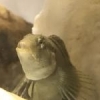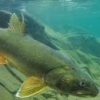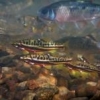
Tank Set Up Thoughts
#1

Posted 14 January 2015 - 02:20 PM
I've come into possession a tank and my plan is to build it as a stream tank, with darters and other peaceful fish as the key species. It's a 75 gallon tank (although, I have two 55 gallon tanks not in use, so I may use one of them instead). I'd like to capture and keep species from a particular stream. In fact, I'd like everything in the tank to come from the stream, from the substrate to the rocks and anything else. It will be my slice of my favorite small stream.
Anyway, if I do that, then I have two options for setting it up as I see it.
1) To collect the substrate and other things that go into the tank and completely sterilize them, then cycle the tank as you would any new tank (no fish method). Then, add fish after quarantine and treatment of potential parasites. This is the safest approach.
But... part of me is thinking this way:
2) To collect the substrate, rocks and other tank objects and let the tank cycle naturally, without sterilization or cleaning. Then, run the tank fallow for a couple months to kill off potential fish parasites and at the same time establish a good population of critters for the darters to feed on. I realize that the fish will eventually consume almost everything, but maybe not. Still, that has to be a healthier way to keep thing, I'd think. I would still quarantine any new fish, including the first inhabitants. I may add a refugium or something like it at a later date to keep a good place for amphipods and copepods to multiply...
And, if you've tried both methods, have you noticed a different in your fishes health? If there is no difference, then perhaps I'd better take the safest way...
Has anyone tried #2? What are your thoughts?
Kevin Wilson
#2

Posted 14 January 2015 - 02:31 PM
#3

Posted 14 January 2015 - 03:05 PM
I've used fresh sand from a local creek without cleaning it. Unless the area you plan to get it from is really dirty/polluted , I wouldn't sweat it.
Josh Blaylock - Central KY
NANFA on Facebook
KYCREEKS - KRWW - KWA
I hope to have God on my side, but I must have Kentucky.
- Abraham Lincoln, 1861
#4

Posted 14 January 2015 - 05:06 PM
I have added lots of substrate, plants, rocks, branches, leaves, etc. to my tanks (oh and fish too). I sometimes think that we stress things more by quarantining them in a sterile, blank, smaller than our normal system, environment... maybe even doing more harm than good... best things for fish is clean water and good food... but right after that is an appropriate hiding space or appropriate tank mates that make the place feel natural to them and reduces stress. OK, maybe that was a derail...
Back on track... I like your idea of collecting it wild and then running it for a while to make sure it is all stable... then add fishes.
#5

Posted 15 January 2015 - 11:08 AM
I agree with Josh... do not go sterile, go natural... this is what the reef people do when they culture live rock in the ocean these days (also used to be the way in the old days of collecting live rock).
I have added lots of substrate, plants, rocks, branches, leaves, etc. to my tanks (oh and fish too). I sometimes think that we stress things more by quarantining them in a sterile, blank, smaller than our normal system, environment... maybe even doing more harm than good... best things for fish is clean water and good food... but right after that is an appropriate hiding space or appropriate tank mates that make the place feel natural to them and reduces stress. OK, maybe that was a derail...
Back on track... I like your idea of collecting it wild and then running it for a while to make sure it is all stable... then add fishes.
I also agree with everything Michael said.
I've been adding rocks, driftwood, etc, even fish, without any cleaning or quarantine for many years. You may have to live with snails and insect larvae you didn't plan on but the fear of diseases and parasites is mainly a throwback to the tropical hobby where conventional wisdom says "kill everything".
The only caveats I would add;
First, if you take sand or gravel, don't dig too deep. Just scoop the lively thin top layer and avoid stagnant deep layers.
Second, use good judgment when you select creatures or objects to add. Don't take from dirty, polluted, stagnant water and don't add critters if you observe any sick looking ones near by.
Your theory of leaving the tank fishless for over 30 days is a sound one but the tank will not cycle and the bio-filter won't mature without the "food" provided by the fish waste, uneaten food etc.
I don't know, maybe it was the roses.
#6

Posted 15 January 2015 - 01:04 PM
Gerald Pottern
-----------------------
Hangin' on the Neuse
"Taxonomy is the diaper used to organize the mess of evolution into discrete packages" - M.Sandel
#7

Posted 15 January 2015 - 01:15 PM
Your theory of leaving the tank fishless for over 30 days is a sound one but the tank will not cycle and the bio-filter won't mature without the "food" provided by the fish waste, uneaten food etc.
True... you have to feed the tank even though there are no fish in there. Just a pinch of flake everyday, like if you only had two fish to feed. The snails and what not will eat some and some will decompose and feed your biofliter.
#8

Posted 15 January 2015 - 02:01 PM
If I'm bringing in fresh gravel and rock, wouldn't the necessary bacteria already be there which will shorten the cycle? I was thinking that I could always add a small crayfish to add some life and keep it fed. I know that I'd have to get rid of it prior to adding the fish.
Kevin Wilson
#9

Posted 15 January 2015 - 05:48 PM
Fishless cycling. IMO the only way to go. This gives you the basics. The most important thing is using an ammonia that is pure, one without surfactants. I did a fishless cycle on tanks in my greenhouse. 2000 gallons. I used some hardcore ammonia due to the size, but you do not need that in your case. I got the filtration to a point that it was consuming so much ammonia that when I introduced 900- 1.5 inch fish in one day, that I had no spike in ammonia or nitrites. No stress on the fish other than moving them from my basement to the greenhouse.
The fish food will do roughly the same thing, but you can use the fishless cycling system to build up so much nitrifying bacteria that you can fully stock the aquarium, and the bacteria will die back to what is needed.
Just to finish the story, I grew 900 fish to 6 inches in 5 months in just over 2 gallons of water per fish with no water changes. It is an aquaponics system, and the fish were blue tilapia.
The member formerly known as Skipjack
#10

Posted 15 January 2015 - 06:53 PM
aquaponics system
Wow, this is interesting. I've never really heard of that before even though during my web tank research I've seen pictures of them...cool concept. It's almost like a gigantic algae scrubber!
Kevin Wilson
#11

Posted 15 January 2015 - 07:18 PM
Sponge filters are so versatile.
The member formerly known as Skipjack
#12

Posted 15 January 2015 - 08:03 PM
But I agree with everything said here previously. My favorite substrate out of all the tanks I have is the gravelly cobbley stuff I collected myself, amended a bit with a few hunks of geode from Kentucky.
Derek Wheaton
On a mountain overlooking the North Fork Roanoke River on one side, the New River Valley on the other, and a few minutes away from the James River watershed...the good life...
Enchanting Ectotherms
My Personal Facebook (mostly fish related, if you'd like to add me)
#13

Posted 15 January 2015 - 08:29 PM
The member formerly known as Skipjack
#14

Posted 16 January 2015 - 08:28 AM
....I started just keeping extra sponge filters in various tanks. If I wanted to start a new tank, or just hold fish, as I was selling a good bit of fish at the time, I would just pull cycled sponge filters from a tank add them and fish to the new tank, and done. If I did not want to keep a sponge filter in the tank, I could run an HOB on it for a month with the sponge, then remove the sponge.
Sponge filters are so versatile.
This is also what I do. I try and plan ahead and will add one or more filters to existing tanks.
I set up the filters for my saltwater tropical strays in July, didn't collect my first fish until September. New tank w/new water but well established filters. Easier than fishless cycling, especially as I don't use test kits. No good way of judging progress in fishless cycling w/o measuring the NH3.
I don't know, maybe it was the roses.
#15

Posted 16 January 2015 - 08:34 AM
.... My favorite substrate out of all the tanks I have is the gravelly cobbley stuff I collected myself, amended a bit with a few hunks of geode from Kentucky.
I also love my natural gravel but lacking pieces of geodes I like to mix in a few ancient, native American produced flakes of quartz and even a broken point or two. Even been known to drop in a flake or two of the colonial era blue and white glazed pottery.
Which reminds me, Gerald is right to warn about sifting out the nails and bottlecaps etc. Have found plenty of that crap in my natural substrates.
I don't know, maybe it was the roses.
#16

Posted 16 January 2015 - 11:45 AM
Josh Blaylock - Central KY
NANFA on Facebook
KYCREEKS - KRWW - KWA
I hope to have God on my side, but I must have Kentucky.
- Abraham Lincoln, 1861
#17

Posted 16 January 2015 - 12:53 PM
The member formerly known as Skipjack
#18

Posted 16 January 2015 - 01:17 PM
#19

Posted 16 January 2015 - 02:58 PM
I don't know, maybe it was the roses.
#20

Posted 16 January 2015 - 03:45 PM

I used to see these at Petco when I was working there and always thought they'd look great on the bottom of a fishtank.
Derek Wheaton
On a mountain overlooking the North Fork Roanoke River on one side, the New River Valley on the other, and a few minutes away from the James River watershed...the good life...
Enchanting Ectotherms
My Personal Facebook (mostly fish related, if you'd like to add me)
1 user(s) are reading this topic
0 members, 1 guests, 0 anonymous users













